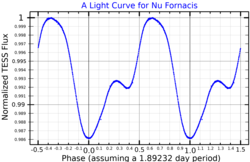Astronomy:Nu Fornacis
| Observation data Equinox J2000.0]] (ICRS) | |
|---|---|
| Constellation | Fornax |
| Right ascension | 02h 04m 29.43861s[2] |
| Declination | −29° 17′ 48.5477″[2] |
| Apparent magnitude (V) | 4.69[3] (4.68 – 4.73[4]) |
| Characteristics | |
| Spectral type | B9.5IIIspSi[5] |
| U−B color index | −0.51[3] |
| B−V color index | −0.17[3] |
| Variable type | α2 CVn[6] |
| Astrometry | |
| Radial velocity (Rv) | +18.50[7] km/s |
| Proper motion (μ) | RA: +12.79[8] mas/yr Dec.: +8.48[8] mas/yr |
| Parallax (π) | 8.79 ± 0.26[2] mas |
| Distance | 370 ± 10 ly (114 ± 3 pc) |
| Absolute magnitude (MV) | −0.60[9] |
| Details | |
| Mass | 3.65±0.18[10] M☉ |
| Radius | 3.44[11] R☉ |
| Luminosity | 245[10] L☉ |
| Temperature | 13,400[12] K |
| Rotation | 1.89[12] d |
| Rotational velocity (v sin i) | 50±5[12] km/s |
| Other designations | |
| Database references | |
| SIMBAD | data |
Nu Fornacis, Latinized from ν Fornacis, is a single,[13] variable star in the southern constellation of Fornax. It is blue-white in hue and faintly visible to the naked eye with an apparent visual magnitude that fluctuates around 4.69.[3] This body is located approximately 370 light years distant from the Sun based on parallax,[2] and is drifting further away with a radial velocity of +18.5 km/s.[7] It is a candidate member of the Pisces-Eridanus stellar stream, which suggests an age of 120 million years or less.[14]
This object is an Ap star[15] with a stellar classification of B9.5IIIspSi[5] matching a late B-type giant star. The 'Si' suffix indicates an abundance anomaly of silicon. It is an Alpha2 Canum Venaticorum variable that ranges from magnitude 4.68 down to 4.73 with a period of 1.89 days – the same as its rotational period.[6][12] It is 3.65 times as massive and 245 times as luminous as the Sun,[10] with 3.44 times the Sun's diameter.[11]
References
- ↑ "MAST: Barbara A. Mikulski Archive for Space Telescopes". Space Telescope Science Institute. https://mast.stsci.edu/portal/Mashup/Clients/Mast/Portal.html.
- ↑ 2.0 2.1 2.2 2.3 van Leeuwen, F. (2007). "Validation of the new Hipparcos reduction". Astronomy and Astrophysics 474 (2): 653–664. doi:10.1051/0004-6361:20078357. Bibcode: 2007A&A...474..653V. http://www.aanda.org/articles/aa/full/2007/41/aa8357-07/aa8357-07.html. Vizier catalog entry
- ↑ 3.0 3.1 3.2 3.3 Ducati, J. R. (2002). "VizieR Online Data Catalog: Catalogue of Stellar Photometry in Johnson's 11-color system". CDS/ADC Collection of Electronic Catalogues 2237. Bibcode: 2002yCat.2237....0D.
- ↑ Samus, N. N. et al. (2009). "General Catalogue of Variable Stars". VizieR On-line Data Catalog: B/GCVS. Originally Published in: 2009yCat....102025S 1. Bibcode: 2009yCat....102025S.
- ↑ 5.0 5.1 Abt, Helmut A.; Morrell, Nidia I. (July 1995). "The relation between Rotational Velocities and Spectral Peculiarities among A-type stars". The Astrophysical Journal Supplement Series 99: 135–172. doi:10.1086/192182. Bibcode: 1995ApJS...99..135A.
- ↑ 6.0 6.1 Samus, N. N. et al. (2017). "General Catalogue of Variable Stars". Astronomy Reports. 5.1 61 (1): 80–88. doi:10.1134/S1063772917010085. Bibcode: 2017ARep...61...80S.
- ↑ 7.0 7.1 Wilson, R. E. (1953). "General Catalogue of Stellar Radial Velocities". Washington (Carnegie Institution of Washington). Bibcode: 1953GCRV..C......0W.
- ↑ 8.0 8.1 8.2 "* nu. For". SIMBAD. Centre de données astronomiques de Strasbourg. http://simbad.u-strasbg.fr/simbad/sim-basic?Ident=%2A+nu.+For.
- ↑ Anderson, E.; Francis, Ch. (2012). "XHIP: An extended hipparcos compilation". Astronomy Letters 38 (5): 331. doi:10.1134/S1063773712050015. Bibcode: 2012AstL...38..331A.
- ↑ 10.0 10.1 10.2 North, P. (1998). "Do SI stars undergo any rotational braking?". Astronomy and Astrophysics 334: 181–87. Bibcode: 1998A&A...334..181N.
- ↑ 11.0 11.1 Shulyak, D. et al. (2014). "Interferometry of chemically peculiar stars: Theoretical predictions versus modern observing facilities". Monthly Notices of the Royal Astronomical Society 443 (2): 1629. doi:10.1093/mnras/stu1259. Bibcode: 2014MNRAS.443.1629S.
- ↑ 12.0 12.1 12.2 12.3 Leone, F. et al. (2000). "A spectroscopic study of the magnetic chemically peculiar star nu Fornacis". Astronomy and Astrophysics 359: 635–38. Bibcode: 2000A&A...359..635L.
- ↑ Eggleton, P. P.; Tokovinin, A. A. (September 2008). "A catalogue of multiplicity among bright stellar systems". Monthly Notices of the Royal Astronomical Society 389 (2): 869–879. doi:10.1111/j.1365-2966.2008.13596.x. Bibcode: 2008MNRAS.389..869E.
- ↑ Curtis, Jason L. et al. (August 2019). "TESS Reveals that the Nearby Pisces─Eridanus Stellar Stream is only 120 Myr Old". The Astronomical Journal 158 (2): 11. doi:10.3847/1538-3881/ab2899. 77. Bibcode: 2019AJ....158...77C.
- ↑ Chen, P. S. et al. (May 2017). "A New Photometric Study of Ap and Am Stars in the Infrared". The Astronomical Journal 153 (5): 28. doi:10.3847/1538-3881/aa679a. 218. Bibcode: 2017AJ....153..218C.
 |


